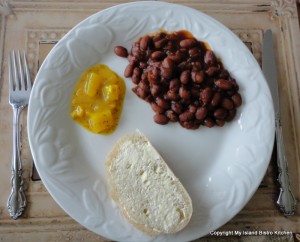
Growing up, Baked Beans was a traditional Saturday night supper in our household. While I haven’t continued the Saturday night tradition, I do frequently have Baked Beans on the menu. Continue reading Maple Syrup Baked Beans

Growing up, Baked Beans was a traditional Saturday night supper in our household. While I haven’t continued the Saturday night tradition, I do frequently have Baked Beans on the menu. Continue reading Maple Syrup Baked Beans

Growing up in rural PEI, one of my favourite Spring-time memories was the tapping of maple trees, going to collect the sap every evening after supper, and watching the sap being boiled down on the stove for hours to make just a tiny bit of maple syrup. It was a rite of Spring and heralded the beginning of warmer days after a long, cold Winter!
While not big industry on PEI, there are a few maple syrup producers who tap trees and make and sell maple syrup each Spring. I recently visited the producers of Woodland Maple Syrup in Woodville Mills about 9 km from Cardigan in the Eastern end of PEI. There, I met Richard MacPhee and Max Newby who were busy with their maple syrup production. Having been operating for 15 years, they proved to be good sources of information on maple syrup production.

This Spring, MacPhee and Newby had 450 taps running. This process depends heavily on cold, frosty nights (about -5ºC) and warmer days (+5 ºC). The alternating freezing and thawing causes the pressure in the tree to change and forces the sap to start running when the temperature rises during the day. On PEI, there is a short window of opportunity to produce maple syrup, typically a 5-6 week period in March/April.
Trees must be at least 10” in diameter to be tapped and trees of that size are usually 40-50 years old. Holes are drilled into the maple trees and spouts are inserted. Buckets with covers to keep out bark, dirt, and rain are then hung on the spouts and are used to collect the dripping sap.


Drilling holes into the tree and removing sap is not harmful to the maple trees and the same trees can be tapped year after year, provided new holes are drilled each time. It is not uncommon to have up to 3 taps in large trees. In fact, Max showed me one large old maple tree just outside the sugar shack that had three taps running and we examined the tree’s maple syrup producing history as we found various marks from previous years’ tappings.

The sap is clear, has no color, and has the consistency of water. I found it had little taste although it is 2% – 4% sugar and I could detect a slightly mild sweet taste but certainly nothing like the taste of the sweet maple syrup that is eventually produced from the sap.

While some operations collect the sap through a network of pipelines strung between trees, at Woodland they tap individual trees using the spout and bucket method. Once every two days, the sap is collected from each tapped tree and placed in a large tank on the front of a tractor and transported to another large holding tank just outside the sugar shack. The sap is then piped into the evaporator inside the sugar shack where the boiling process takes place.

The sap is boiled in a large pan on a wood-fired evaporator until most of the water in it is boiled off and it boils down to a thick syrup.


This can take hours, not to mention patience and a close eye to make sure the sap does not boil too robustly and overflow the pan.


Sap is continually added to the pan as the water evaporates so it is a continuous process. The boiling process causes a chemical reaction to occur in the sap and transforms it into a flavourful syrup.

It takes between 50-60 gallons of sap to make just 1 gallon of maple syrup. The syrup is then filtered to remove any remaining impurities and, at Woodland, the last filtering is through felt which is a thick, dense fabric through which no impurities will pass. The syrup is then ready for bottling.
There are different grades of maple syrup and grading is based on color. The lighter the color, the higher the quality of syrup but the more subtle the taste. The more amber, darker colored syrup has more flavour but, in grading terms, would be considered a lower grade syrup. Light-colored syrup is traditionally used as a table syrup for pancakes, waffles, and French toast. Darker colored syrup, on the other hand, is well suited for cooking and baking – e.g., ice creams and brulées as well as sauces and glazes for meats.

Woodland produces approximately 200 litres of maple syrup each year which they sell locally from their sugar shack and also sell to Island restaurants. The syrup can also be purchased locally on PEI at Riverview Country Market on Riverside Drive in Charlottetown.
Maple syrup is a good source of manganese and riboflavin and contains antioxidants that boost immunity.
Maple syrup has multiple uses. Perhaps the most commonly known is at the breakfast table on pancakes, waffles, and French toast. However, it can also be widely used in many different cooking and baking recipes. Over the next while, I will be posting some recipes using Island-produced maple syrup from Woodlands so be sure to come back and visit my website to see what is cooking and baking.

——————
There are lots of ways to connect with “the Bistro” through social media:
Join My Island Bistro Kitchen on Facebook
Follow the Bistro’s tweets on twitter @PEIBistro
Find the Bistro on Pinterest at “Island Bistro Kitchen”
Follow along on Instagram at “PEIBistro”